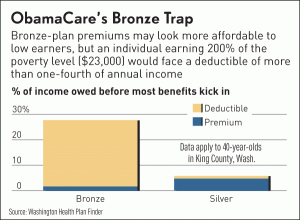Many of ObamaCare’s advocates believe that the proportion of a household’s income spent on health care is an appropriate measure of how effective health insurance is at doing its job. If a household spends ten percent or more of income on health care, it is said to be “underinsured” by the Commonwealth Fund or the Kaiser Family Foundation. Five percent is the cut-off for low-income households.
According to that standard, ObamaCare fails miserably at insuring low-income households:
In Washington, one in four individuals in households earning less than 250% of the poverty level signed up for a bronze plan with a deductible of $5,000-$6,350 per person and $10,000-$12,700 per family. Even after premiums, these households could face medical costs ranging from 17% to 40% of income before ObamaCare’s non-preventative-care benefits kick in.
Beyond the premium subsidies that the law provides, households earning up to 250% of the poverty level qualify for cost-sharing assistance. It can greatly reduce the deductible that must be exhausted before benefits kick in and, after that, the co-payments required for medical services and prescription drugs. But those cost-sharing subsidies are available only for those who buy silver-level coverage…

Source:Investor’s Business Daily.
 The Physicians Foundation and Merritt Hawkins (a physician recruiting firm) have just published their biennial physicians’ survey. The survey interviews over twenty thousand physicians in all fifty states and multiple specialties:
The Physicians Foundation and Merritt Hawkins (a physician recruiting firm) have just published their biennial physicians’ survey. The survey interviews over twenty thousand physicians in all fifty states and multiple specialties:








